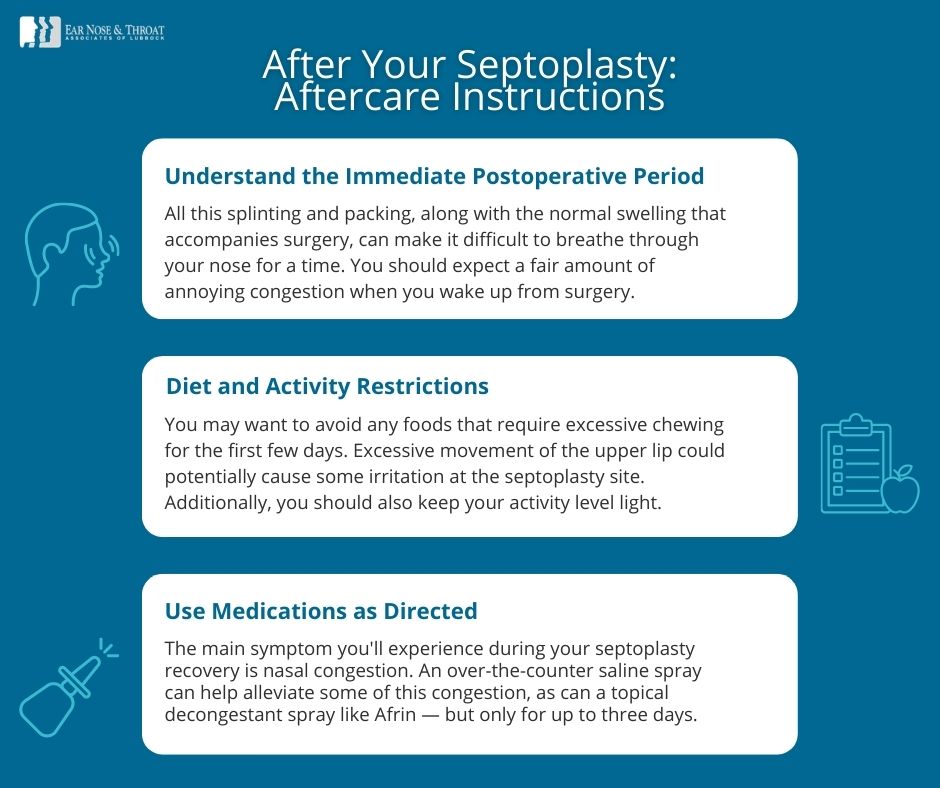How To Have a Quick and Comfortable Septoplasty Recovery

Planning a surgery is usually accompanied by a fair amount of anxiety. The thought of the procedure itself can be unsettling, but then you start to think about the recovery. Will it be difficult? Will it be painful?
Fortunately, septoplasty recovery is neither. In reality, it’s more annoying than anything, due to the stuffiness and congestion that tend to follow surgery.
Typically, however, patients are breathing easier within a week, often for the first time in years — maybe for the first time in their lives.
In this post, we’ll discuss what a septoplasty is, what’s involved in septoplasty aftercare, and how to make your septoplasty recovery as quick and comfortable as possible.
What’s a Septoplasty?
A septoplasty is a common surgery performed on the nose to correct a deviated septum.
The nasal septum is the wall that divides your nose in half; it’s composed of bone and cartilage. The design of the septum allows for smooth airflow through both sides of the nose so that the sinuses can function optimally.
Sometimes, however, the nasal septum can become deviated, or crooked, either from birth or trauma. This can prevent good airflow through the nose, causing snoring, sleep apnea, and overall difficulty breathing, especially on one side.
A severely deviated septum can inhibit breathing on both sides of the nose and force people to breathe through their mouths. This can lead to a dry mouth and frequent bloody noses.
Common symptoms of a deviated septum can include:
- Dry mouth.
- Difficulty sleeping.
- Headaches.
- Facial pain.
- Frequent sinus infections.
A septoplasty involves making a small incision inside the nose at the septum, lifting the lining, and straightening the deviated septum while removing as little bone and cartilage as possible. Although a minor deviated septum can be fixed under local anesthesia, you’ll need general anesthesia for most septoplasties.
After Your Septoplasty: Aftercare Instructions
One of the best ways to ensure a smooth septoplasty recovery is to follow all of the septoplasty aftercare instructions your surgeon gives you. Here are a few things we recommend.

Understand the Immediate Postoperative Period
The septoplasty procedure itself takes 30–60 minutes. You’ll wake up from surgery with an IV in your arm or hand and dissolvable packing material in your nose. You’ll also have plastic splints in your nose to help hold the septum straight while it heals.
All of this splinting and packing, along with the normal swelling that accompanies surgery, can make it difficult to breathe through your nose for a time. So although septoplasty will help you breathe through your nose better in the long run, you should expect a fair amount of annoying congestion when you wake up from surgery.
Diet and Activity Restrictions
It’s a good idea to keep your meals light for the first few days after general anesthesia. Increase your diet as tolerated, from liquids to soft, light foods, and don’t move to heavy foods until your stomach has completely settled.
You may want to avoid any foods that require excessive chewing for the first few days. Excessive movement of the upper lip could potentially cause some irritation at the septoplasty site.
Additionally, you should also keep your activity level light. Walking around the house to keep your blood pumping is recommended following general anesthesia, but you should avoid strenuous activities that cause heavy breathing, like running or weightlifting.
Use Medications as Directed
Fortunately, most patients don’t require pain medication after a septoplasty, though some may need a pain pill for the first night or two to help them sleep. Ibuprofen as needed is an acceptable pain medication for septoplasty aftercare, and it can also keep your inflammation levels down.
Expect some bleeding for the first 24 hours after surgery. After that, the main symptom you’ll experience during your septoplasty recovery is nasal congestion. An over-the-counter saline spray can help alleviate some of this congestion, as can a topical decongestant spray like Afrin — but only for a day or two. (After three days, Afrin will cause a phenomenon known as rebound congestion.)
Other Tips To Make Your Septoplasty Recovery More Comfortable
An ice pack over your nose can help alleviate some of the swelling and discomfort following surgery. We also recommend sleeping in an upright position (propped up with multiple pillows or in a recliner) to make breathing easier while your post-surgery congestion lasts.
Don’t Be Afraid of Septoplasty Recovery
As you can see, there’s little to fear from a septoplasty recovery. The process isn’t usually painful, though it can be annoying and uncomfortable, and recovery is quick. Once the splints come out, your nose will start to feel normal again. And within one to two weeks, you’ll find yourself feeling better than normal — because you can breathe freely and easily!
Dr. Scolaro is a board-certified Otolaryngologist servicing the South Plains area. He has been practicing in Lubbock since 1990 and has earned a reputation as a skilled and experienced surgeon. He currently serves as the Medical Director for Covenant High Plains Surgery Center campuses, is a member of Covenant Health Partners and is an adjunct faculty professor for Texas Tech University Health Sciences Center School of Medicine. Learn more about Dr. Scolaro.
Categories:








